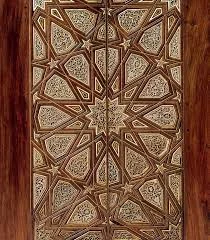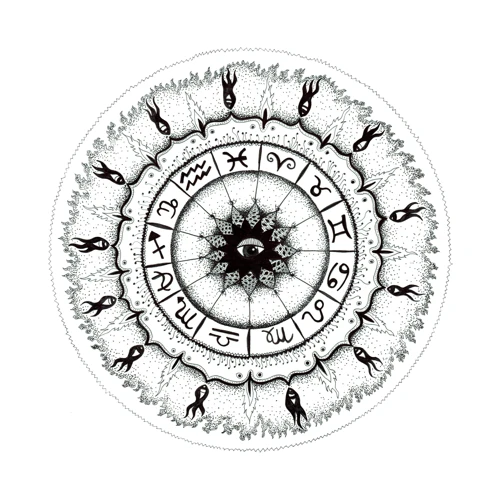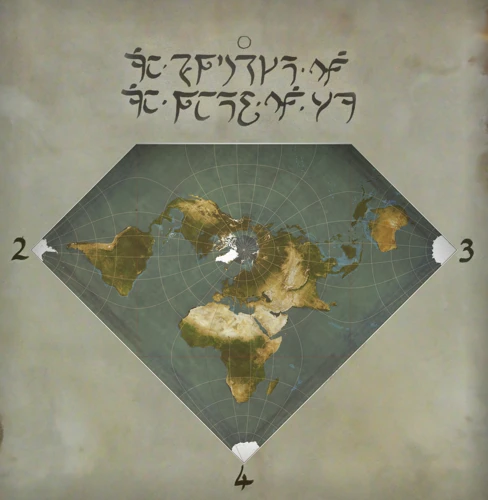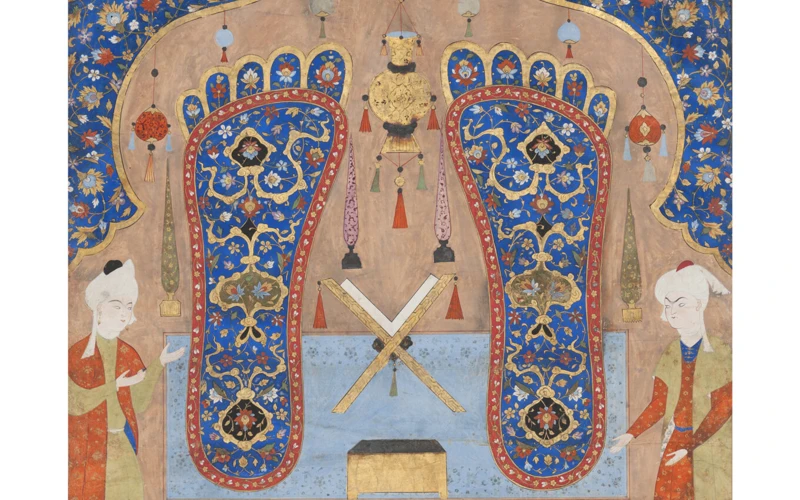Geometric Patterns in Islamic Art: Unveiling the Intricate Beauty of Sacred Geometry
Enter a world where art and mathematics intertwine, creating masterpieces that have captivated generations of admirers. Islamic art is renowned for its exquisite beauty and rich symbolism, with geometric patterns at its heart. These intricate designs, rooted in sacred geometry, evoke a sense of awe and wonder, reflecting the harmony and balance found in the Islamic faith. In this article, we will delve into the significance of Islamic art and the role of geometry in its creation. Join us on a journey to explore the mesmerizing world of Islamic geometric patterns, uncovering their key elements, techniques for construction, and the symbolism they hold. We will also discover how these timeless patterns continue to inspire modern design. Be prepared to be mesmerized by the harmony and complexity of Islamic geometric art.
The Significance of Islamic Art

Islamic art holds immense significance in the cultural and religious context of the Islamic world. It serves as a visual representation of the rich tradition, spirituality, and beliefs found within Islamic culture. Islamic art encompasses various forms, including calligraphy, architecture, ceramics, textiles, and more. The art form has a deep connection to the Islamic religion, as the use of figurative imagery is generally avoided in order to respect the belief in the oneness of God and prevent idolatry. Instead, Islamic art focuses on geometric patterns, intricate designs, and calligraphy. These elements not only reflect the mathematical precision valued in Islamic culture but also serve as a means of expressing devotion to God. Islamic art is often seen as a form of meditation, as it encourages contemplation and reflection on the divine. Through its beauty and symbolism, Islamic art seeks to convey the magnificence of God’s creation, the interconnectedness of all things, and the pursuit of spiritual harmony. It is an art form that combines aesthetics and spirituality, captivating viewers and fostering a sense of awe and reverence for the divine.
The Role of Geometry in Islamic Art

Geometry plays a central role in Islamic art, serving as the foundation for its intricate and mesmerizing designs. The use of geometry in Islamic art can be traced back to the early Islamic period, where it became a fundamental element in the creation of various art forms. Geometry is seen as a way to symbolize the order and harmony found in the universe, reflecting the belief in the divine nature of geometric patterns. Islamic art often incorporates geometric shapes such as circles, squares, triangles, and polygons, which are meticulously arranged to create complex patterns. These patterns are not only visually captivating but also hold symbolic meanings. The repetition of geometric motifs signifies infinity, as it has no beginning or end. It represents the eternal nature of God and the belief in divine perfection. Additionally, the intricate geometric designs found in Islamic art have practical implications as well. The use of geometric principles allows for precise measurements, balance, and symmetry in the creation of architecture, textiles, and ceramics. The intricacy and precision of geometric patterns in Islamic art showcase the mastery and skill of the artists, while also serving as a visual expression of the interconnectedness and harmony of the natural world. Through the meticulous application of geometry, Islamic artists aim to create a sense of awe, contemplation, and spiritual transcendence in the viewer. The role of geometry in Islamic art is a testament to the deep-seated connection between mathematics, spirituality, and aesthetics.
Exploring Islamic Geometric Patterns

Islamic geometric patterns are a window into the mesmerizing world of sacred geometry, showcasing the mathematical precision and artistic ingenuity of Islamic art. To explore these patterns is to embark on a journey of awe and wonder, uncovering the secrets of their construction and the significance they hold. Understanding the basics is crucial, such as the use of circles and squares as a foundation, along with symmetry and repetition. These patterns often incorporate key elements such as stars, polygons, and arabesque motifs, each with their own symbolic meanings. Techniques for creating these patterns range from simple grid constructions to more complex interlocking designs. The influence of Islamic geometric patterns can be found in various aspects of art and architecture, from the intricately designed mosque domes to elaborate tile works and even illuminated manuscripts. This exploration of Islamic geometric patterns unveils the harmonious marriage of mathematics and art, showcasing the profound beauty and cultural significance they possess.
1. The Basics of Islamic Geometric Patterns
Islamic geometric patterns are a hallmark of Islamic art and are characterized by their intricacy and mathematical precision. These patterns are constructed using a set of fundamental elements and principles. One of the key elements is the use of circles, which are often divided into equal sections to create repetitive motifs. These circles are then intersected by lines, creating a framework of polygons such as squares, triangles, and hexagons. The process of creating Islamic geometric patterns involves the repetition and interconnection of these geometric shapes, resulting in elaborate and symmetrical designs. The use of symmetry is another fundamental aspect of these patterns, with various forms of symmetry, including reflection, rotation, and translation, being employed. These patterns can be seen adorning various forms of Islamic art, such as architecture, ceramics, and textiles. They not only showcase the mastery of geometry but also serve as a visual representation of the harmony and order believed to be inherent in the universe. Islamic geometric patterns have a rich history that dates back centuries, and their influence can be observed in various cultures and civilizations throughout history. From the intricate designs of medieval Islamic mosques to the mesmerizing patterns found in ancient architecture, Islamic geometric patterns continue to fascinate and inspire. /mystery-platonic-solids/
2. Key Elements of Islamic Geometric Patterns
Key Elements of Islamic Geometric Patterns
Islamic geometric patterns are characterized by several key elements that contribute to their mesmerizing beauty and intricate complexity. These elements come together harmoniously to create visually stunning designs that are deeply rooted in mathematical principles and Islamic symbolism.
1. Repetition: Repetition is a fundamental element in Islamic geometric patterns. Shapes, lines, and motifs are repeated in a precise and symmetrical manner, creating a sense of rhythm and unity within the design. This repetition represents the infinite nature of God and the eternal nature of the universe.
2. Interlocking: Interlocking shapes and lines are another integral part of Islamic geometric patterns. These interconnections symbolize the interconnectedness of all things within the universe. The seamless blending of various shapes and forms represents the unity and harmony of creation.
3. Complexity: Islamic geometric patterns often exhibit a high level of complexity. The designs are meticulously crafted, using intricate combinations of circles, squares, polygons, and stars. The complexity not only showcases the skill of the artists but also demonstrates the depth of knowledge and appreciation for geometry within Islamic culture.
4. Mathematical Precision: Islamic geometric patterns are rooted in mathematical principles such as symmetry, proportion, and tessellation. These patterns are created using precise measurements and calculations, showcasing the importance of mathematics in Islamic art. The use of mathematical precision reflects the belief in the order and harmony inherent in the universe.
5. Sacred Symbols: Islamic geometric patterns often incorporate sacred symbols such as the eight-pointed star (khatim), the four-fold rosette (Iznik), and the arabesque. These symbols carry deep spiritual and cultural significance within Islamic art and serve as a reminder of the divine presence.
By understanding these key elements, we can truly appreciate the sophisticated artistry and profound symbolism that Islamic geometric patterns possess. Their timeless beauty and mathematical precision continue to inspire and captivate people across cultures and generations.
3. Popular Geometric Shapes and Motifs
Islamic geometric patterns are characterized by a rich array of shapes and motifs that are meticulously crafted to create stunning visual compositions. These shapes and motifs hold deep symbolism and are often repeated in Islamic art. Let’s explore some of the most popular ones:
1. Stars: Stars hold significant symbolism in Islamic art, representing both the divine light of God and the cosmos. Various star patterns, such as the eight-pointed star, can be found in Islamic geometric designs, adorning everything from mosque domes to ceramics.
2. Arches: Arches are an iconic element in Islamic architecture, often showcasing intricate geometric patterns. These arches symbolize the gateway to paradise and are commonly seen in mosque entrances, mihrabs, and minarets.
3. Interlocking Circles: Interlocking circles, also known as the “flower of life,” are a popular motif in Islamic art. These circles symbolize unity, harmony, and the interconnectedness of creation. They are commonly found in tilework, carpets, and geometric compositions.
4. Hexagons: Hexagons are extensively used in Islamic geometric patterns. They represent balance and perfection. Hexagonal tiling can be seen in the layout of tiles on walls and floors, creating mesmerizing repeating patterns.
5. Calligraphy: Calligraphy, the art of beautiful writing, is an integral part of Islamic art. Arabic script is often used to incorporate sacred verses from the Quran into geometric designs, infusing them with deeper spiritual meaning.
These shapes and motifs are expertly combined and repeated to create complex and symmetrical designs that are visually captivating. The ancient civilizations of Central America, such as the Maya, also utilized geometric shapes in their art and architecture, creating intriguing connections between diverse cultures and their reverence for mathematical precision and sacred geometry.
4. Techniques for Creating Geometric Patterns
Creating geometric patterns in Islamic art requires precision, meticulousness, and a deep understanding of mathematical principles. Here, we will explore some of the techniques used to construct these mesmerizing patterns.
1. Grid-based Construction: One of the fundamental techniques involves creating a grid as the foundation for the pattern. The grid provides a framework for organizing and aligning the geometric elements. The grid can be simple, consisting of intersecting horizontal and vertical lines, or more complex, with additional diagonal lines. This grid guides the placement and proportions of the geometric shapes.
2. Symmetry and Repetition: Symmetry is a key element in Islamic geometric patterns. Artists use various types of symmetry, such as reflection, rotation, and translation, to create harmonious and balanced designs. Often, a single geometric motif is repeated and mirrored multiple times to form intricate patterns that extend infinitely.
3. Compass and Straightedge: Traditional Islamic artists often rely on the compass and straightedge as their primary tools. These simple yet powerful tools allow for the precise construction of circles, lines, and arcs, which are the building blocks of many geometric patterns. By using these tools, artists can achieve the exacting precision required to create intricate designs.
4. Interlocking Patterns: Interlocking patterns are another hallmark of Islamic geometric art. In these designs, geometric shapes seamlessly fit together, with no gaps or overlaps. This technique requires careful calculation and meticulous execution to ensure that the patterns seamlessly interlock, creating a visually captivating effect.
These techniques for creating geometric patterns in Islamic art have been passed down through generations, preserving the tradition and beauty of this sacred art form. By employing these methods, artists continue to produce awe-inspiring designs that showcase the complexity and precision of Islamic geometric patterns.
The Symbolism of Islamic Geometric Patterns

The symbolism embedded within Islamic geometric patterns is both profound and multi-layered. These intricate designs go beyond their aesthetic appeal and carry deep spiritual significance. One of the key themes in Islamic geometric patterns is unity. The repetition of geometric shapes and symmetrical arrangements represents the concept of oneness and the interconnectedness of all things in the universe. The use of circles, for example, symbolizes the unity of God and the eternal nature of creation. They are seen as a reflection of the divine perfection and infinity. Additionally, the incorporation of geometric patterns in Islamic art also represents the harmony and balance emphasized in the Islamic faith. The calculated precision and meticulous construction of these patterns reflect the order and discipline sought in a devotee’s spiritual journey. Islamic geometric patterns often feature star-like motifs, which symbolize divine light, illumination, and guidance. These motifs are inspired by the heavenly bodies and the belief in the guiding presence of God. The integration of sacred geometry in Islamic art serves as a reminder to believers of the divine order in the universe and the quest for spiritual enlightenment. By contemplating these patterns, one can strive for a deeper connection with the divine, finding solace and inspiration in the intricacies and symbolism they hold. The symbolism of Islamic geometric patterns can be likened to the universal language of sacred geometry, which finds resonance in various ancient architectures and cultures, such as the Maya civilization’s mathematical foundations in the construction of their pyramids.
The Harmonious Nature of Sacred Geometry

Sacred geometry is a fundamental aspect of Islamic art, infusing it with a harmonious and balanced aesthetic. Rooted in mathematical principles and cosmic symbolism, sacred geometry represents the interconnectedness of all creation. It is a language that transcends cultural and religious boundaries, serving as a universal expression of beauty and order. The geometric patterns found in Islamic art follow strict rules and proportions, creating a sense of harmony and balance. Sacred geometry explores geometric shapes such as circles, squares, triangles, and hexagons, which have symbolic meanings in Islamic culture. For example, the circle symbolizes unity and infinity, while the square represents stability and the earthly realm. These geometric shapes are arranged in intricate patterns, often repeating and interlocking to form complex designs. The repetition of patterns represents the infinite nature of God’s creation. The use of symmetry in Islamic geometric patterns is also significant, reflecting the idea of balance and equilibrium. Whether displayed in the mesmerizing architecture of mosques or in intricate tilework, sacred geometry in Islamic art creates a visual harmony that resonates with viewers and cultivates a sense of tranquility. It is a visual representation of the order and perfection inherent in the natural world and the universe at large. By contemplating these geometric patterns, one can experience a connection to the divine and gain a deeper understanding of the underlying principles that govern existence. The harmonious nature of sacred geometry in Islamic art serves as a reminder of the unity and beauty found within the Islamic faith and the wider world around us. For further exploration of sacred geometry in ancient architecture, you may navigate to the article about “sacred geometry in ancient architecture”.
Examples of Islamic Geometric Artworks

Islamic geometric artworks are a testament to the exquisite craftsmanship and artistic brilliance of Islamic artisans throughout history. One remarkable example of Islamic geometric art can be found in the architecture of mosques. The intricate patterns adorning the walls, domes, and minarets of these sacred spaces display a harmonious blend of geometry and spirituality. These patterns, often formed by interlocking shapes such as stars, polygons, and arabesques, create mesmerizing visual effects that evoke a sense of awe in observers. Another stunning embodiment of Islamic geometric art can be seen in the intricate designs of ceramics and tiles. Islamic artisans skillfully arrange geometric motifs, such as the famous arabesque, to adorn pottery and tiles, resulting in stunning works of art that captivate the eye. Illuminated manuscripts and calligraphy are also showcases of Islamic geometric art, with expertly crafted letters and geometric patterns combining to form visually stunning pages. These examples of Islamic geometric artworks not only showcase the exceptional skill and creativity of Islamic artisans but also emphasize the cultural and spiritual significance of geometric patterns within Islamic art. Through geometric art, Islamic craftsmen and artists have left a lasting legacy of beauty and inspiration for generations to come.
1. The Beauty of Mosque Architecture
Mosque architecture is a pinnacle of Islamic art, displaying exquisite beauty and intricate detailing. These sacred spaces are not only places of worship but also serve as visual representations of Islamic identity and expression. The design of mosques is a fusion of geometric patterns, calligraphy, and architectural elements, creating awe-inspiring structures that hold a profound spiritual significance. The use of geometric patterns in mosque architecture is rooted in the Islamic emphasis on mathematical precision and harmony. Intricate geometric motifs such as stars, polygons, and interlocking patterns adorn walls, domes, and minarets. These patterns are not only decorative but also carry symbolic meanings. For example, the repetition of geometric forms symbolizes the infinite nature of God, while the interlocking patterns symbolize the unity and interconnectedness of the Islamic community. The arrangement of geometric elements also creates a sense of balance and harmony, inviting worshippers to experience a tranquil and meditative environment. The mesmerizing beauty of mosque architecture showcases the seamless integration of mathematics, art, and spirituality in Islamic culture, leaving visitors in awe of its grandeur and grace. To learn more about the intersection of mathematics and ancient architecture, you can explore the wonders of Mathematics in Mayan Pyramids.
2. Intricacy in Ceramics and Tiles
Intricacy in Ceramics and Tiles
Ceramics and tiles play a significant role in Islamic art, showcasing the exquisite intricacy and mastery of craftsmanship. Islamic ceramics can be found in various forms, from delicate pottery to elaborate tiles adorning mosques and palaces. These creations often feature mesmerizing geometric patterns that reflect the precise mathematical principles of Islamic art. The tiles are meticulously designed, with each element carefully placed and meticulously arranged to create a harmonious whole. The intricate patterns found on Islamic ceramics often incorporate motifs such as stars, flowers, and calligraphy. One famous example of Islamic ceramic work is the stunning blue and white ceramic tiles of the Iznik tradition, which flourished during the Ottoman Empire. These tiles are adorned with intricate geometric designs, floral motifs, and Arabic calligraphy, creating a visual feast for the eyes. The use of vibrant colors, such as cobalt blue, turquoise, and emerald green, adds to the allure of these artworks. The geometric patterns on Islamic ceramics and tiles not only serve an ornamental purpose but also symbolize the spiritual significance intertwined within Islamic culture. Each pattern has a deeper meaning, representing concepts like unity, infinity, and the divine order. The beauty and complexity of Islamic ceramics and tiles continue to inspire modern design and architecture, showcasing the timeless appeal of sacred geometry. To learn more about the influence of Islamic geometric patterns on ancient architecture, you can read our article on Sacred Geometry in Ancient Architecture.
3. Illuminated Manuscripts and Calligraphy
Illuminated manuscripts and calligraphy play a prominent role in Islamic art, showcasing the exquisite craftsmanship and dedication to the written word. These art forms hold a special place in Islamic culture, as they not only serve as a means of preserving and transmitting knowledge but also as a form of spiritual expression.
Manuscripts: Islamic illuminated manuscripts are meticulously crafted books adorned with intricate designs and embellishments. These manuscripts often contain religious texts such as the Quran or poetry by renowned Islamic scholars. The pages are embellished with gold leaf, vibrant colors, and delicate geometric patterns, creating a visually stunning aesthetic. The intricate designs and illustrations within the manuscripts not only enhance the visual appeal but also serve as symbols of the divine.
Calligraphy: Calligraphy, the art of beautiful handwriting, holds a revered position in Islamic art. The written word, especially religious verses, is considered sacred in Islam, and calligraphers dedicate years to mastering this art form. Islamic calligraphy is characterized by its fluidity, elegance, and intricate embellishments. Various calligraphic scripts are employed, including Kufic, Naskh, and Thuluth, each with its distinct style and application. Calligraphy can be found not only in religious texts but also in architectural elements, ceramic tiles, and other forms of Islamic art.
Both illuminated manuscripts and calligraphy serve as a medium to connect individuals with the words of the divine. The intricate patterns and stylized letters within these art forms convey a sense of reverence and spiritual significance. They invite viewers to contemplate the profound meanings and teachings encapsulated within the written word, inspiring a deeper connection with the Islamic faith.
Illuminated manuscripts and calligraphy in Islamic art showcase the profound devotion to the written word and the aesthetics associated with these art forms. These masterpieces serve as visual representations of the sacred texts and embody the harmonious blend of spirituality and artistry within Islamic culture.
The Influence of Islamic Geometric Patterns on Modern Design
The influence of Islamic geometric patterns on modern design is undeniable. These timeless patterns have transcended time and place, inspiring artists, architects, and designers around the world. One of the ways in which Islamic geometric patterns have influenced modern design is through their use in architecture. Many contemporary buildings incorporate elements of Islamic geometry, such as intricate tile work, arabesque motifs, and geometric patterns, to create visually stunning and culturally significant structures. These designs not only pay homage to the rich heritage of Islamic art but also add a sense of depth, complexity, and elegance to modern architectural aesthetics.
In addition to architecture, Islamic geometric patterns have found their way into various aspects of interior design. From wallpaper to textiles, furniture to lighting fixtures, these patterns are used to infuse spaces with a sense of timeless beauty and cultural richness. The intricate nature of Islamic geometric patterns adds a layer of sophistication and visual interest to any room, creating a unique and captivating ambiance.
The influence of Islamic geometric patterns can also be seen in the world of graphic design. From logos to packaging, these patterns are utilized to add a sense of depth, harmony, and cultural resonance to visual communications. The precision and intricacy of Islamic geometric patterns lend themselves well to digital design, allowing for the creation of visually striking and memorable graphics.
The influence extends beyond design disciplines as well. Islamic geometric patterns have inspired artists in fields such as jewelry design, fashion, and even product design. The symmetrical and intricate patterns are beautifully incorporated into accessories, clothing, and everyday objects, adding an element of sophistication and cultural significance.
The timeless allure and intricate beauty of Islamic geometric patterns continue to captivate and inspire designers across various disciplines. By incorporating these patterns into modern design, artists and creators pay homage to the rich cultural heritage of Islamic art while infusing contemporary aesthetics with a touch of tradition and spirituality.
Conclusion
In conclusion, the exploration of geometric patterns in Islamic art reveals the profound significance and beauty of sacred geometry. Islamic art showcases the intricate interplay between mathematics, spirituality, and cultural expressions. The geometric patterns found in Islamic art not only demonstrate the mathematical skill and precision of the artists but also serve as a visual representation of the Islamic belief in the harmony and balance of creation. These patterns are not merely decorative but carry deeper symbolism, representing the unity and transcendence of God. They serve as a means of contemplation and reflection, inviting viewers to connect with the divine and appreciate the interconnectedness of all things. Moreover, Islamic geometric patterns continue to inspire and influence modern design, bridging the gap between tradition and contemporary aesthetic sensibilities. The mesmerizing beauty and cultural significance of Islamic geometric art make it a timeless and captivating art form that continues to inspire and educate people around the world. Through the study and appreciation of Islamic art, we gain a greater understanding of the cultural heritage and spiritual depth of the Islamic world.
Frequently Asked Questions
1. What is the origin of Islamic art?
Islamic art originated in the 7th century CE, following the rise of Islam in the Arabian Peninsula. It developed as a unique artistic expression influenced by diverse cultures, including Persian, Byzantine, and Indian.
2. What are the main characteristics of Islamic geometric patterns?
Islamic geometric patterns are characterized by intricate, symmetrical designs composed of geometric shapes such as squares, circles, stars, and polygons. These patterns often utilize repetition, grid structures, and interlocking motifs.
3. Why are figurative images avoided in Islamic art?
In Islamic tradition, the creation of figurative images can be seen as a form of idolatry, which goes against the belief in the oneness of God. Islamic art emphasizes non-figurative elements such as geometry, calligraphy, and abstract patterns.
4. How were Islamic geometric patterns created?
Islamic geometric patterns were meticulously created using compasses and rulers to achieve precise measurements and symmetry. These patterns were often constructed using a grid system and a set of mathematical rules to ensure harmonious designs.
5. What is the symbolism behind Islamic geometric patterns?
Islamic geometric patterns hold deep symbolism. The repetitive nature of the patterns represents the eternal and infinite nature of God. The precision and balance in the designs reflect the order and harmony present in the universe, while the intricate complexity serves as a reminder of the divine intelligence.
6. How did Islamic geometric patterns influence modern design?
The mesmerizing beauty and mathematical principles found in Islamic geometric patterns have influenced various areas of modern design. From architecture to interior design, textiles to graphic design, these patterns have inspired contemporary artists and designers, adding a touch of cultural richness and aesthetic appeal.
7. What is the connection between Islamic art and calligraphy?
Calligraphy is considered a major form of artistic expression in Islamic art. Arabic script, particularly Quranic verses and prayers, are often beautifully written and incorporated into various art forms. Calligraphy, like geometric patterns, has a close connection to Islamic spirituality and serves as a means of expressing devotion to God.
8. How do Islamic geometric patterns create a sense of harmony?
Islamic geometric patterns demonstrate a remarkable sense of harmony through the balance and symmetrical arrangement of shapes and motifs. The repetitive and interconnected nature of these patterns evokes a visual rhythm that is both pleasing to the eye and reflective of the underlying order found in the natural world.
9. What are some famous examples of Islamic geometric artwork?
Examples of Islamic geometric artwork can be found in various forms. The intricate geometric designs in mosque architecture, the mesmerizing patterns on ceramics and tiles, and the meticulous geometric ornamentation in illuminated manuscripts and calligraphy are just a few notable examples of Islamic artistic achievements.
10. Can anyone learn to create Islamic geometric patterns?
Absolutely! While Islamic geometric patterns require precision and knowledge of mathematical concepts, anyone can learn to create them with practice and guidance. There are resources available, including books, workshops, and online tutorials, that make the process accessible to enthusiasts and aspiring artists alike.








